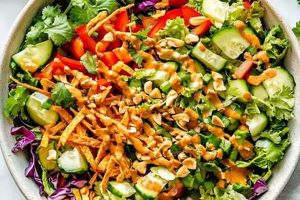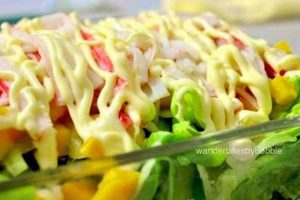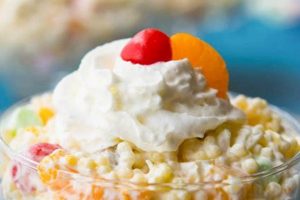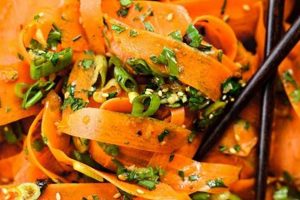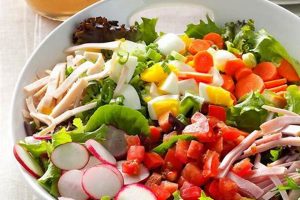Congealed salads, often featuring gelatin as a key ingredient, encompass a broad range of dishes incorporating diverse elements such as fruits, vegetables, nuts, and sometimes meat or whipped cream. A classic example involves dissolving flavored gelatin in boiling water, then chilling the mixture until it sets. Various ingredients are then suspended within the gelatin, creating a colorful and textured dish.
These dishes gained popularity, particularly in the mid-20th century, due to their ease of preparation, affordability, and the perceived novelty of their jiggly texture. They offer a refreshing and visually appealing option for desserts, side dishes, or even main courses depending on the incorporated ingredients. Their adaptability allows for both sweet and savory variations, making them suitable for a variety of occasions from casual family meals to festive gatherings.
This exploration will delve into the versatility of these gelatin-based creations, covering aspects like classic variations, modern adaptations, tips for successful preparation, and creative presentation ideas. It aims to provide a comprehensive resource for both novice cooks and experienced culinary enthusiasts seeking to explore the world of molded salads.
Tips for Creating Perfect Gelatin-Based Salads
Achieving optimal results with gelatin-based salads requires attention to detail and a few key techniques. The following tips will help ensure success and enhance both the flavor and presentation of these versatile dishes.
Tip 1: Bloom the Gelatin: Sprinkling gelatin granules over cold water before dissolving them in hot liquid allows for even hydration and prevents clumping, resulting in a smooth, consistent texture.
Tip 2: Temperature Control: Avoid adding hot gelatin mixtures directly to cold ingredients, especially those containing dairy or fresh fruit, as this can cause separation or curdling. Allow the gelatin to cool slightly before incorporating other components.
Tip 3: Mold Preparation: Lightly oiling the mold before adding the gelatin mixture ensures effortless unmolding and maintains the integrity of the salad’s shape. For intricate molds, briefly dipping them in warm water can further facilitate release.
Tip 4: Layering Techniques: Creating layered salads requires allowing each layer to set completely before adding the next. This prevents colors from bleeding and maintains distinct visual appeal.
Tip 5: Ingredient Incorporation: Ensure ingredients such as fruits and vegetables are evenly distributed within the gelatin mixture to create a balanced flavor and visual presentation. Smaller pieces often work best for even suspension.
Tip 6: Chilling Time: Allow ample chilling time for the gelatin to fully set. This typically requires several hours in the refrigerator. Avoid freezing, as this can compromise the texture.
Tip 7: Creative Garnishes: Enhance presentation by garnishing the unmolded salad with complementary elements such as fresh herbs, whipped cream, or a sprinkle of chopped nuts.
By following these guidelines, one can elevate gelatin-based dishes from simple to spectacular, showcasing their potential for both culinary creativity and elegant presentation. Mastery of these techniques enables the creation of truly impressive and delightful salads.
With a deeper understanding of the nuances involved, cooks can confidently experiment with flavors, textures, and presentation, transforming classic gelatin salads into culinary masterpieces.
1. Gelatin Selection (Type, Flavor)
Gelatin selection represents a foundational element in crafting a successful jelly salad. The chosen gelatin’s characteristics significantly influence the final product’s flavor profile, texture, and overall aesthetic. Careful consideration of gelatin type and flavor is crucial for achieving desired results.
- Gelatin Type
Various gelatin types exist, including powdered, sheet, and vegetarian alternatives like agar-agar. Powdered gelatin is commonly used due to its widespread availability and ease of use. Sheet gelatin offers a more refined texture and is often preferred for professional culinary applications. Agar-agar, derived from seaweed, provides a vegan-friendly option. The selected type impacts the setting time and final consistency of the jelly salad.
- Flavor Profile
Gelatin is available in a wide array of flavors, from classic options like strawberry, lemon, and lime to more exotic choices such as pineapple or mango. Selecting a flavor that complements the intended salad ingredients is essential. A sweet fruit-flavored gelatin pairs well with fresh berries and whipped cream, while a savory, unflavored gelatin provides a neutral base for vegetable or meat-based salads.
- Flavor Intensity
The concentration of flavor within the chosen gelatin also requires consideration. Some gelatins offer a more intense flavor profile than others. Adjusting the amount of liquid used or incorporating additional flavorings can help balance the intensity and create a harmonious blend of tastes.
- Sugar Content
Gelatins vary in their sugar content. Some are sweetened, while others are sugar-free, allowing for greater control over the overall sweetness of the salad. Consider the sweetness of other ingredients when selecting a gelatin to avoid an overly sweet or bland final product. Sugar-free options cater to dietary restrictions and offer versatility in flavor customization.
These factors collectively influence the final character of the jelly salad. Harmonizing gelatin type, flavor profile, intensity, and sugar content with the other ingredients creates a balanced and appealing dish. A well-chosen gelatin elevates the overall culinary experience, transforming a simple combination of ingredients into a cohesive and delightful culinary creation.
2. Complementary Ingredients
Complementary ingredients represent a crucial aspect of jelly salad recipes, significantly impacting the final dish’s sensory experience. The thoughtful selection and incorporation of these ingredients elevate the salad beyond a simple gelatin base, adding layers of flavor, texture, and visual appeal. A successful jelly salad relies on the synergistic relationship between the gelatin and its accompanying components.
Ingredients contribute distinct characteristics, interacting with the gelatin’s inherent qualities. Fruits introduce sweetness, tartness, and varied textures; examples include the juicy burst of berries, the segmented firmness of citrus fruits, or the smooth creaminess of bananas. Vegetables offer contrasting textures and savory notes, such as the crisp snap of celery, the subtle sweetness of carrots, or the peppery bite of radishes. Nuts provide crunch and richness, with options like chopped walnuts, pecans, or slivered almonds enhancing both flavor and mouthfeel. Dairy elements, such as whipped cream or yogurt, contribute a creamy texture and tangy counterpoint to the gelatin’s sweetness. The interplay of these diverse ingredients creates a complex and harmonious flavor profile.
Consider a lime-flavored gelatin base. Adding chopped pineapple and shredded coconut creates a tropical-inspired salad, where the pineapple’s sweetness and tang complement the lime’s tartness, while the coconut provides textural contrast. Alternatively, a savory salad can be crafted using unflavored gelatin, incorporating diced cucumber, shredded carrots, and chopped fresh dill. The vegetables provide a refreshing crunch, while the dill adds a herbaceous note. Understanding these ingredient interactions empowers culinary creativity, allowing for endless flavor combinations and textural variations. Careful selection of complementary ingredients elevates the jelly salad from a simple dish to a culinary expression, demonstrating the transformative power of thoughtful ingredient pairings.
3. Mold preparation
Mold preparation constitutes a critical stage in crafting visually appealing and structurally sound jelly salads. The mold’s shape, size, and material influence the final presentation and ease of serving. Appropriate preparation ensures the seamless release of the set gelatin, preserving the intended form and preventing damage during unmolding. This process directly impacts the aesthetic appeal and overall success of the jelly salad.
- Mold Selection
Mold selection dictates the final shape and size of the jelly salad. Various options exist, ranging from simple bowls and loaf pans to intricate bundt pans and decorative molds. Consider the occasion and desired aesthetic when selecting a mold. A fluted bundt pan creates an elegant presentation for a festive gathering, while individual ramekins offer portion control and visual variety.
- Material Considerations
Molds are available in various materials, including metal, glass, plastic, and silicone. Each material possesses unique properties that influence mold preparation. Metal molds conduct heat efficiently, facilitating rapid chilling and setting. Glass molds offer clarity, showcasing the layered beauty of complex salads. Silicone molds provide flexibility, allowing for easy release of delicate shapes. The chosen material influences both the setting process and the ease of unmolding.
- Preparing the Mold
Proper preparation ensures the effortless release of the set gelatin. Lightly coating the interior surface of the mold with a thin layer of neutral oil, such as vegetable or canola oil, prevents sticking. Avoid using flavored oils, as they can impart unwanted tastes to the delicate gelatin. For intricate molds, a brief dip in warm water can further aid in releasing the salad without damage.
- Unmolding Techniques
Careful unmolding preserves the salad’s shape and presentation. Before unmolding, gently loosen the edges of the gelatin by running a thin knife or spatula around the mold’s perimeter. Invert the mold onto a serving platter and gently shake or tap to release the salad. For stubborn salads, briefly wrapping the mold in a warm, damp cloth can aid in the release process. Patience and a gentle touch are key to successful unmolding.
Successful mold preparation ensures the jelly salad’s structural integrity and enhances its visual presentation. The chosen mold, material, and preparation techniques contribute significantly to the final product’s aesthetic appeal and ease of serving. A beautifully unmolded salad, reflecting the careful attention paid to mold preparation, elevates the dining experience, transforming a simple dish into a visually stunning culinary creation.
4. Chilling and Setting
Chilling and setting are fundamental processes in jelly salad preparation, directly influencing the final product’s texture, structural integrity, and overall success. Adequate chilling transforms the liquid gelatin mixture into a semi-solid state, creating the desired jiggly consistency characteristic of these salads. Understanding the factors affecting this transformation is crucial for achieving optimal results.
- Temperature’s Role
Temperature plays a critical role in gelatin setting. Lower temperatures promote faster setting, while higher temperatures slow down or inhibit the process. Refrigeration provides the ideal temperature range for consistent and reliable gelatin setting. Placing the prepared salad in the coldest part of the refrigerator further expedites the process. Conversely, warmer ambient temperatures may lead to incomplete setting or a weaker structure.
- Gelatin Concentration
The concentration of gelatin within the mixture directly influences the setting time and firmness of the final product. Higher gelatin concentrations result in faster setting and a firmer texture, while lower concentrations require longer chilling times and yield a softer consistency. Recipe instructions typically specify the appropriate gelatin-to-liquid ratio for optimal results. Adjusting this ratio allows for customization of the salad’s texture based on individual preferences.
- Ingredient Influence
Certain ingredients can affect gelatin setting. Enzymes present in fresh fruits like pineapple, kiwi, and papaya can inhibit gelatinization. These enzymes break down the gelatin proteins, preventing proper setting. To incorporate these fruits, they should be cooked or canned before adding them to the gelatin mixture, as heat deactivates the enzymes. Alternatively, using enzyme-free gelatin allows for the incorporation of fresh fruit without affecting the setting process.
- Setting Time
Setting time varies based on factors such as gelatin concentration, temperature, and the presence of inhibiting ingredients. Most jelly salads require several hours of refrigeration to fully set. Insufficient chilling time results in a weak structure and a less desirable texture. Checking for firmness by gently touching the surface of the salad indicates whether it has fully set. A firm, non-sticky surface signifies complete setting.
The interplay of these factors determines the optimal chilling and setting conditions for a successful jelly salad. A thorough understanding of these elements empowers control over the final product’s texture and structural integrity. Precisely managing these variables ensures a delightful culinary experience, transforming a simple mixture into a perfectly set and visually appealing jelly salad.
5. Presentation and Serving
Presentation and serving represent the culmination of the jelly salad creation process, significantly impacting the perceived quality and overall enjoyment of the dish. While flavor and texture are paramount, visual appeal elevates the dining experience. Thoughtful presentation transforms a simple jelly salad into an enticing culinary creation, enhancing its perceived value and creating a memorable impression.
- Serving Vessels
The choice of serving vessel plays a crucial role in presentation. Elegant glass bowls showcase the vibrant colors and intricate layers of the salad. Individual ramekins or dessert cups offer portion control and a touch of formality. Platters provide a larger canvas for elaborate arrangements and garnishes. The serving vessel should complement the salad’s style and the occasion.
- Garnishing Techniques
Garnishes enhance visual appeal and add complementary flavors. Fresh mint sprigs, berries, whipped cream, or a sprinkle of chopped nuts elevate the presentation and provide contrasting textures. A simple garnish can transform a basic jelly salad into a visually stunning dessert. The choice of garnish should complement the salad’s flavor profile and overall aesthetic.
- Accompanying Elements
Serving the jelly salad alongside complementary elements enhances the dining experience. A dollop of whipped cream, a scoop of ice cream, or a drizzle of custard adds richness and textural contrast. Cookies, wafers, or fresh fruit offer contrasting flavors and textures, creating a balanced and satisfying dessert. Consider the overall flavor profile and occasion when selecting accompanying elements.
- Contextual Considerations
The setting and occasion influence presentation choices. A formal dinner party calls for elegant serving dishes and refined garnishes. A casual picnic or barbecue allows for more rustic presentations and simpler accompaniments. Adapting the presentation to the context ensures a harmonious and appropriate dining experience. The goal is to create a visually appealing and contextually relevant presentation.
These elements of presentation and serving, when thoughtfully considered, elevate the jelly salad from a simple dish to a culinary centerpiece. The interplay of serving vessels, garnishes, accompanying elements, and contextual considerations transforms the sensory experience, enhancing enjoyment and creating a lasting impression. A well-presented jelly salad reflects the care taken in its creation, demonstrating attention to detail and a commitment to culinary excellence.
Frequently Asked Questions
This section addresses common inquiries regarding the preparation and enjoyment of gelatin-based salads, offering clarity and practical guidance for achieving optimal results.
Question 1: How can clumping be prevented when dissolving gelatin?
Clumping can be avoided by sprinkling the gelatin granules over cold water and allowing them to bloom for a few minutes before adding hot liquid. This ensures even hydration of the granules before dissolving.
Question 2: Why does a gelatin salad sometimes fail to set properly?
Several factors can inhibit proper setting, including the use of fresh pineapple, kiwi, or papaya (which contain enzymes that break down gelatin), insufficient chilling time, or an incorrect gelatin-to-liquid ratio. Using canned or cooked versions of these fruits or utilizing enzyme-free gelatin resolves this issue.
Question 3: Can a jelly salad be frozen?
Freezing is generally not recommended, as it can compromise the texture, leading to a less desirable consistency upon thawing. Refrigeration provides the ideal environment for setting and storage.
Question 4: How can one ensure a smooth, even texture in a layered jelly salad?
Allowing each layer to fully set before adding the next prevents mixing and ensures distinct layers. Cooling the gelatin mixture slightly before adding it to a cold layer helps avoid separation.
Question 5: What are suitable alternatives for vegetarian or vegan diets?
Agar-agar, a plant-based gelling agent derived from seaweed, serves as an excellent alternative to traditional gelatin. It offers similar setting properties and can be used in various culinary applications.
Question 6: How long can a jelly salad be stored in the refrigerator?
Properly stored in an airtight container, a jelly salad can typically be refrigerated for up to 3-5 days, maintaining its quality and flavor. However, the addition of fresh ingredients may shorten the storage time.
Understanding these common inquiries enhances proficiency in gelatin salad preparation. These insights facilitate optimal results and minimize potential challenges, leading to the creation of consistently delicious and visually appealing dishes.
This concludes the frequently asked questions section. The following section will offer a collection of diverse recipe variations, showcasing the versatility and adaptability of gelatin-based salads.
Jelly Salad Recipe
Exploration of gelatin-based salad construction reveals a multifaceted culinary landscape. From foundational elements like gelatin selection and complementary ingredient pairings to the intricacies of mold preparation, chilling, setting, presentation, and serving, each stage contributes significantly to the final product. Mastery of these techniques empowers culinary creativity, enabling the transformation of simple ingredients into visually stunning and texturally delightful dishes. Addressing common preparation challenges further enhances proficiency, ensuring consistent success in creating these versatile culinary creations.
The adaptability of gelatin salads allows for endless variation and customization. This culinary canvas invites exploration of diverse flavor profiles, textural combinations, and artistic presentations. Continued experimentation and refinement of technique promise further evolution of gelatin-based cuisine, solidifying its place as a versatile and enduring culinary tradition.

